2021-12-15
Interview mit Peter Stimmler zur Auszeichnung mit dem Nachwuchs-Engagement-Preis des LBV
Interview between Gabriela Paz Vielma Reyes (GCE student and student assistant at the BayCEER Office) and Peter Stimmler (PhD student at the Department of Agroecology and founder of the LBV Hochschulgruppe Bayreuth) on 18 November 2021
Gabriela: You have been awarded by the LBV for your great commitment to the LBV university group Bayreuth, congratulations! When, why and how was the LBV university group was founded and what is your passion behind this?
Peter: I started about thinking to found a group for students in 2018 and founded it officially in 2019. This was one year after I started my master studies, I studied molecular ecology, more theoretically laboratory-based studies where there are not many possibilities to get in contact with nature and this was something that really disturbed me. I studied molecular medicine before in my bachelor studies and there you have an object of study that is the human being so if you are working as an ecologist you should get in touch also with the object you are studying, in this case nature. This you should do outside not only in a laboratory, because ecology and nature are complex and you just can’t understand it by reading books and making experiments. You have to go out and you have to realize that you also are a part of the system and this really helped me to get a bigger understanding of ecology. I wanted to share this with the students because when I was asking my fellow students questions about ecology and nature, the answers where often on the surface or false and then I invited them to go all together to some excursions outside.
My goal was to help other people realizing their own idea what they are interested in, for example if you are interested in plants, let’s do something about plants, let’s do a presentation or an excursion. I tried to help people to deepen their knowledge about the topic that they are most interested, taking the people by the hand helping them realize their ideas and deepening their knowledge. We started with a dozen of students, there we shaped the summer festival of LBV in the Lindenhof and I wanted that we have a wide diversity topic to cover.
This was about the time of the bees dying discussion and everyone was just talking about bees instead of other insects for example. We wanted to give people an input about these insects dying also behind the bees, the bees are of course part of this ecosystem but you have to understand the whole ecosystem and the problems in that ecosystem. So, then I mobilized a dozen of students to present their own knowledge in this festival and based on this we met every 2 weeks again. We were looking for ideas what we can do starting our own projects and we started writing this program, this year is the 7th edition. By this we want to show people what you can do and explain them different topics and also give them the possibility to do something practical outside the university and give them a free space where they can develop their ideas and their knowledge without this academical pressure you always have but helping the people finding themselves and getting their own idea of the world but founded on scientific data but not just repeating the ideas of the professor.
Gabriela: You were the founding member, right?
Peter: The LBV already existed and it is one of the biggest and oldest in Bayern, but yes, I was the founding member of this university group.
Gabriela: Tell me more in detail about your work that made you deserve the award.
Peter: For founding this group and building it on time, with persistence, throughout all this years there has been a lot of work being done, many hours spent and difficulties but this has been all worth it because of the wonderful group we have and how we have inspired other people to join but also to create their own groups and they can learn from our experience.
Last Tuesday 30.11.21 there was an online meeting with more than 30 people from all over the country that wanted to start a group and were inspired by this work and asked me for help and guidance. This is truly an example of dedication and hard work that with time you can see the fruits of putting your passion and working it together to help people get involved in sustainability and together taking care of this fragile world looking for a better future for next generations.
Gabriela: Do you recommend students to join? Or is it only for people with expertise, background, or anyone can join?
Peter: Everyone can participate and we invite everyone who is interested to approach us and talk to us. You can learn with the others, your peers, you can also enjoy nature even without understanding the process or knowing the names of the species we observe. The idea is to make the students sensitive to these topics and that they understand the importance of nature conservation and beauty of life itself, to share the fascination for nature.
Gabriela: You have topics for a thesis, how does this work?
Peter: Yes, we have many topics that can be used for investigation in Bachelor or Master thesis, they can be in English or German and have many different associated skills and we can also help to be the link between the students and the projects and in this case both parts can benefit and learn from each other. One important thing is that first you need a professor in the university that will be willing to be your guide and to have an external topic of research. Currently we are working together with the university to develop an official procedure for an external thesis.
2020-01-13
Why Science Communication?
Saskia Klink, Agroecology
Have you ever struggled to explain to your parents, grandparents or anyone who is just not familiar with your scientific work what you do in your Bachelor / Master thesis? You’ll probably have realized how hard it can be to find ‘non-scientific’ words to describe what you are doing, so that everyone can understand. You might also have struggles when explaining your work to scientists from other fields of research. What is needed here is science communication – a way to explain to others what you are doing, in a way that they understand without having graduated in your field.
Did you know that science communication already starts when scientists talk about their research with each other? Even though this type of communication often clusters to people with the same scientific background, there are many ways that it can benefit you as a researcher. For example, it helps to make connections with other researchers in your field, to find collaborators, might increase the chance of having your publications known and cited, and thereby might even indirectly or directly increase the chances for funding. But apart from these academic benefits, we often choose our field of study because we want to make a change. We want to make people care about it by increasing our knowledge about processes, connections and consequences and find ways to create benefits for everyone. This means, we not only have to explain our findings to colleagues, but also to the stakeholders who are directly involved and need inputs, help and alternative solutions (e.g. land owners, politicians, industrial companies, conservation institutes). It is important to note that these stakeholders can only benefit from your work if they understand what you are saying.
A really great group of people to talk to when trying to explain your science and make a change are children. Kids are often very interested in nature, their environment and how things work. By explaining your science to them in appropriate language and why it matters to you and might be of importance to them as well, you can help them get a better understanding and feeling for the world they live in. Bonus, they’ll go tell their parents what they learned and what little or bigger changes could help to make a positive contribution – and parents surely will rather listen to their own children than to an unknown scientist.
Importantly, science communication shouldn't be about a one-way communication of information from the scientist to the audience. The best way to communicate science is to have it be a conversation, where both sides benefit and learn from the interaction. We can't assume that the audience won't know something about our topic (e.g. kids will often know a lot about a topic they're interested in already, and land managers will have the best local knowledge of their particular area) so it's important to ask questions of the audience, learn from them, and create a dialogue.
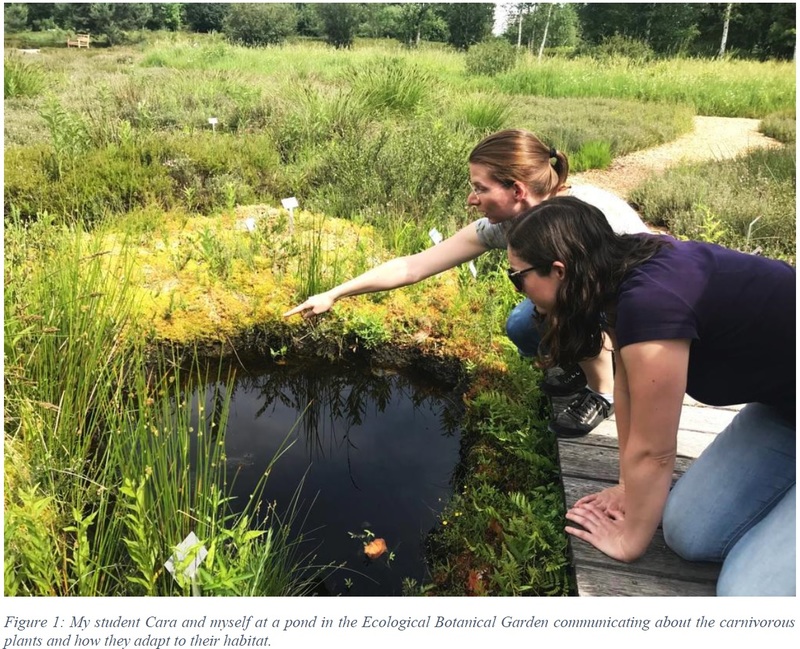
The best way to improve your science communication skills is to practice. Think about what you do and how you would explain it to a child in a way that makes them want to learn more. Talk to your parents, grandparents and neighbors about your science. When you are going to a conference and it offers a workshop on science communication, go for it! Apart from learning how to improve your networking and making useful connections it might help you make your research be more heard – both within and outside of academia.
2019-05-24
Stoichiometric controls of C and N cycling
Per-Marten Schleuss, Meike Widdig, Alexander Guhr, Sarah Martin, Marie Spohn Soil Biogeochemistry & Soil Ecology
Here are the main results of our latest publication from the research project "stoichiometric homeostasis of soil microorganisms as a driver of element cycling in grasslands" within the Emmy Noether program.
Highlights:
- N (and P) additions affected the microbial community but not their C:N stoichiometry
- Long-term N addition changed processes involved in C and N cycling
- Abundance of genes involved in the C cycle increased with elevated N availability
- Microbes invested less into peptidases and increased net N mineralization
- N addition and associated soil acidification reduced C mineralization rates
Elemental stoichiometry constitutes an important concept linking biogeochemistry and microbial C and N cycling, and thus is at the core of ecosystem functioning. Terrestrial ecosystems have experienced rising N and partly P inputs during the last decades changing soil C:N:P availabilities. Yet, the microbial response towards shifting soil element stoichiometry is not well understood. We investigated how long-term N and P additions affect microbial community composition, and to what extent microbial homeostasis explains changes in different processes involved in soil C and N cycling in response to element addition. We studied a 66-year-old nutrient addition experiment in a mesic grassland in South Africa, consisting of four different levels of N addition (0, 7, 14, and 21 g N m-2 yr-1) with and without P addition (0, and 9 g P m-2 yr-1).
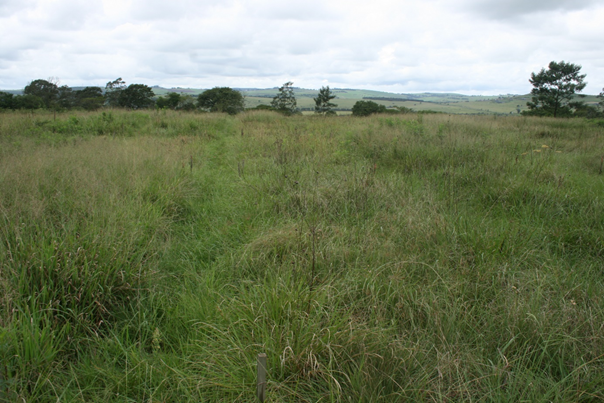
Figure 1: Long-term nutrient addition experiment at the Ukulinga Research Farm (Pietermaritzburg, South Africa)
We show that despite strong changes in the microbial community, the microbial C:N ratio did not change in response to N-addition. The abundance of genes involved in C cycling increased with elevated N availability indicating an upregulation microbial C acquisition. In addition, microbes invested less into peptidases and increased net N mineralization. Our results suggest that changes in the rates of element cycling processes can largely be explained by the property of the soil microbial biomass to adjust metabolic processes to maintain its biomass stoichiometry.
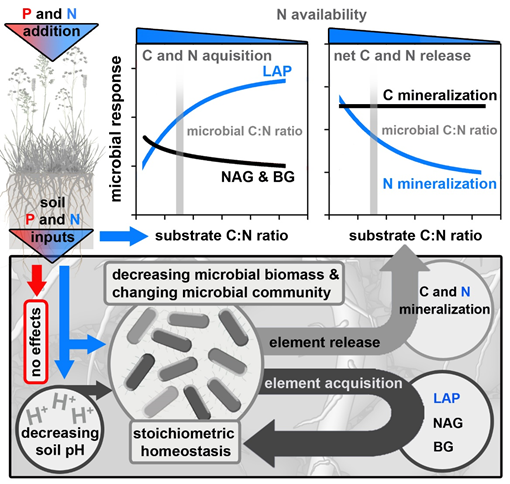
Figure 2: Conceptual figure summarizing the main responses of element cycling: for C (in black), N (in blue) and P (in red). Abbreviations are: (BG) for β-glucosidase, (NAG) for N-acetylglucosaminidase, and (LAP) for leucine-aminopeptidase activities. We show that microorganisms increase C acquisition and N mineralization in response to N addition, which allows the microbial biomass to maintain its biomass stoichiometry. Decreases in C mineralization rates in soils under N addition, however, were not driven by the stoichiometric relationship between the microbial biomass and its environment, but mainly by soil acidification resulting from long-term N addition.
Reference:
Per-Marten Schleuss, Meike Widdig, Anna Heintz-Buschart, Alexander Guhr, Sarah Martin, Kevin Kirkman, Marie Spohn (2019). Stoichiometric controls of soil carbon and nitrogen cycling after long-term nitrogen and phosphorus addition in a mesic grassland in South Africa. Soil Biology and Biochemistry (In Press, Accepted Manuscript). https://doi.org/10.1016/j.soilbio.2019.05.018
Junior Research Group, Soil Biogeochemistry: http://www.bayceer.uni-bayreuth.de/soilbcg/?lang=en
2019-05-07
EGU – interesting research and free coffee
Antonia Fritz & Anita Freundorfer, Micrometeorology Group
At the Europoean Geosciences Union general assembly (EGU) 2019, 16 273 scientists from 113 countries presented 5531 oral, 9432 poster, and 1287 PICO presentations. Among those were many scientists from Bayreuth, including us, the micrometeorology group.
For us, Toni and Anita, it was the first or second time at EGU, respectively. We were impressed by the sheer range of the scientific contributions: microplastic, lightnings and thunderstorms, citizen science, geoscience games, sea level rise and many more. We often had a hard time deciding which session to go to. With all this input, we quickly learned not to miss the free coffee as we needed these coffe breaks for resetting our brain.
In addition to the presentations, the EGU also offered workshops for early career scientists, lots of networking opportunities and many interesting people to talk to. For us it was eye-opening to meet some scientists whose papers we had read before and to realize that they are, in fact, normal people. Furthermore, the EGU offered the opportunity of discussing practical questions about the research, which aren‘t mentioned in papers.
From the scientific point of view, especially the atmospheric science sessions were interesting for us. As the research of the micrometeorology group covers many different fields, our team contributed 6 presentations (1 PICO, 3 posters and 2 orals) in 5 different sessions on urban climate, precipitation and boundary layer meteorology. We received a lot of helpful and positive feedback, had some interesting discussions, and are already looking forward to our next time at EGU.
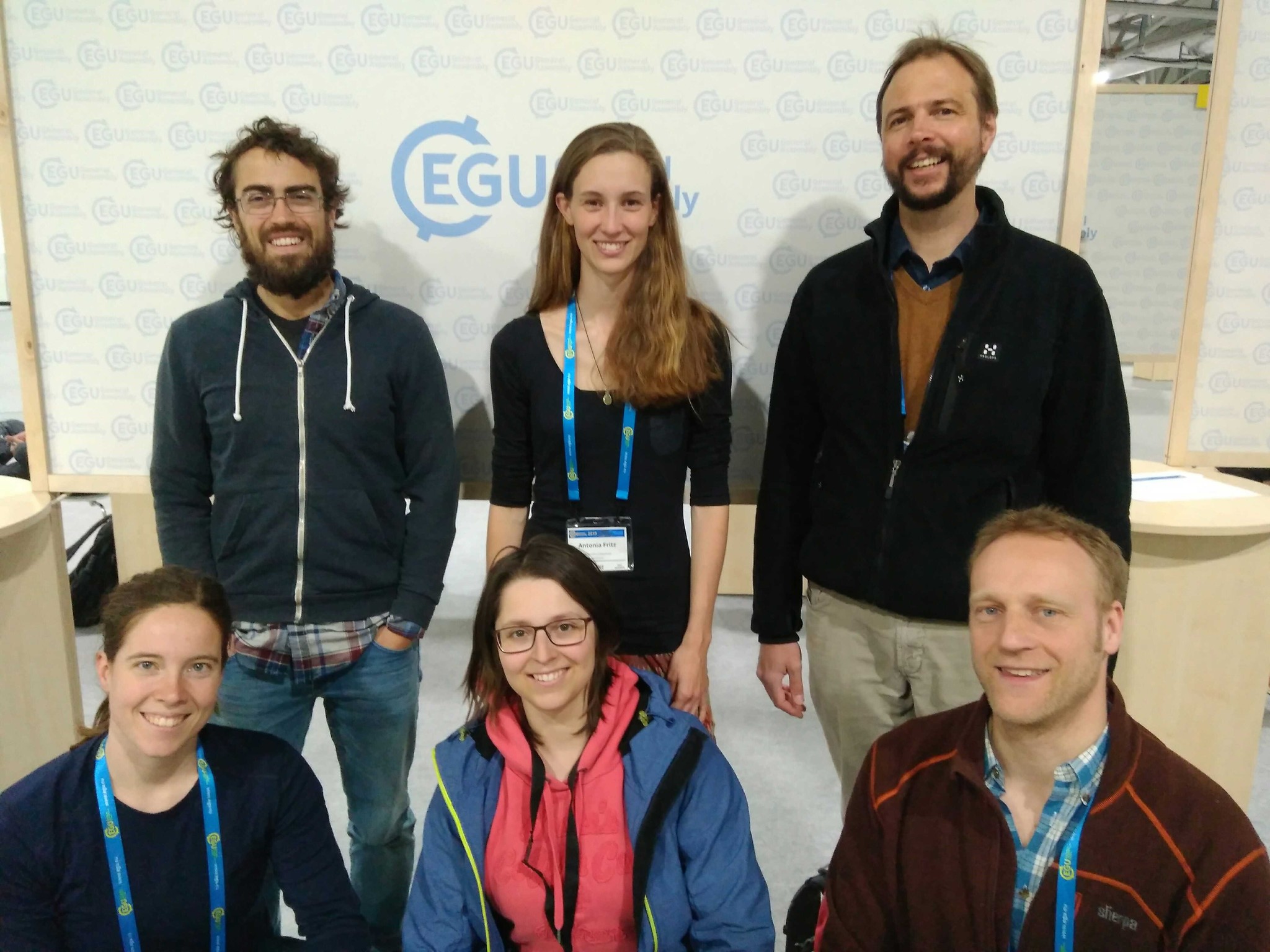
Figure legend:
The micrometeorology group at the EGU: Lena Pfister, Anita Freundorfer, Wolfgang Babel (front from left), Karl Lapo, Antonia Fritz and Christoph Thomas (back from left).
https://www.egu2019.eu/
2019-05-07
Flying halfway across the globe to dig in the dirt – a research stay in Bloomington, USA
Saskia Klink, Agroecology
Within my PhD, I have a collaborative project with the Phillips lab at Indiana University (IU) in Bloomington, Indiana, USA. Together, we are researching forest-nutrient cycles and the role of mycorrhizal fungi which form a symbiotic association with plant roots.
During October and November 2018, I stayed at IU to work on my research project and learn more about the American way of life. The PhD student from the Phillips lab collaborating with me, Adrienne B. Keller, is working on the plots I used as well and could show me how to find the chosen trees in a dense and mountainous forest site. Luckily, close to the campus there exists a field site, Moores Creek Research and Teaching Preserve, with a forest harboring trees with either symbiotic fungi on the root surface (ecto-mycorrhiza) or symbiotic fungi within the root (endo-mycorrhiza), which is exactly what we are looking for. The aim of my project is to measure differences in the decomposition of organic material in the soil by the different fungal types and the consequences of this for the nutrient cycling in the respective ecosystem. For this, I measure the stable isotope signatures of plant material, soil fractions and different fungal functional groups.
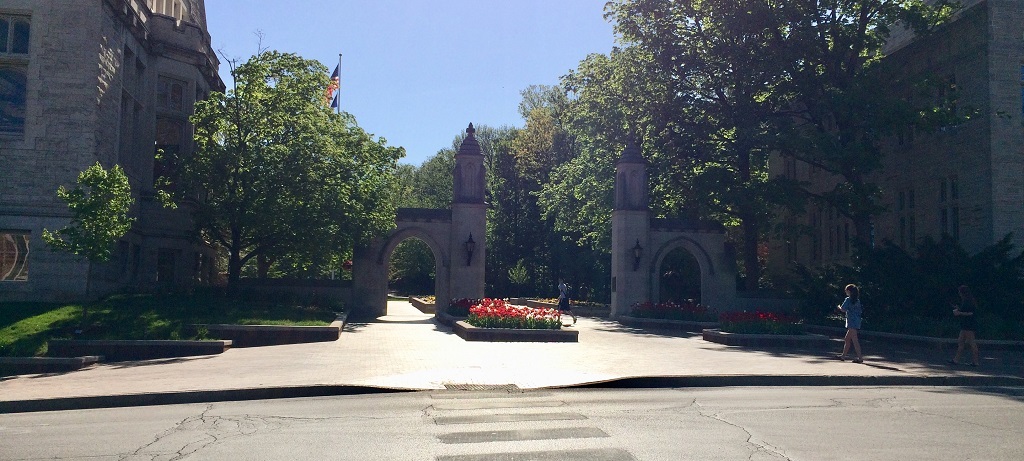
In addition, a lot of environmental parameters are monitored: soil temperature, soil moisture, nutrient content, root biomass and more. To achieve these parameters, soil samples and cores have to be taken, transported to the lab and processed (e.g. sieving to a certain size, removing roots and biota). The group of the Phillips lab was very helpful by finding equipment in the lab (it’s amazing what kind of English words you can learn when searching for equipment) and with instruments for the field work.
In the field, I could enjoy the Indian summer with impressive leaf colors, lots of mushrooms coming out and fancy animals like orange frogs and lizards. At the University I attended a Science fest, where all departments showed parts of their research, and I visited the Glasshouses and enjoyed nice and thoughtful talks. Alongside work, I was impressed by the variety of restaurants one can find in Bloomington. You feel that you can travel around the world by tasting dishes of all kinds of countries (e.g. Nepalese, Indian, Korean, Arabian). A nice Farmers market is held every Saturday at the center of Bloomington, where one can find local food and nice handmade crafts – a very good option for Christmas shopping.
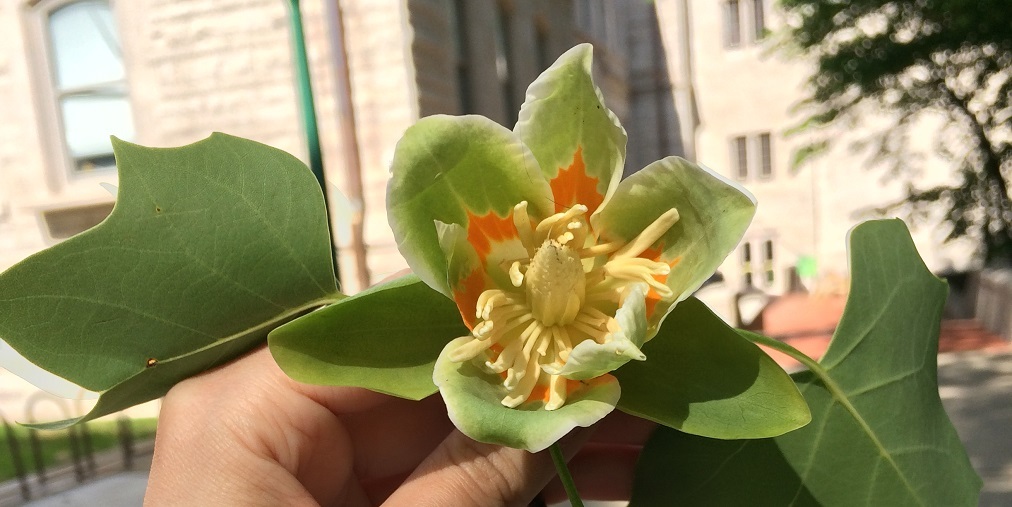
As I visited during October and November, I got to experience Halloween and Thanksgiving. Halloween actually is a big event with all kinds of costumes, parties and sweets. Even the restaurants are decorated with spider webs, pumpkins and scary witches and you can order spooky drinks. Thanksgiving is celebrated at the end of November and is a holiday. I was invited to celebrate it with the family of the lab manager, who created an awesome meal with turkey, baked potatoes, chili, pumpkin cheesecake and apple pie. Some days before the actual Thanksgiving, we had a ‘Friendsgiving’ with the students of the department, were everyone could bring some food, so that we ended up with a huge buffet. Thanksgiving seems to be nearly as big a holiday as Christmas!
I really enjoyed my research stay in Bloomington and am looking forward to going there again next year. The Phillips lab is doing great research and we seem to have a fruitful collaboration. Luckily, I don’t have to wait until next year to see Adrienne again, as she will be visiting Bayreuth University and our department in June. Then it’s time to show her the research at the University, the delicious food of Germany and our stunning nature.
Picture credit:
- Sample Gates at Indiana University
- The national tree of Indiana, the Tulip Poplar (Liriodendron tulipifera)
- Fungi (Rhizomarasmius pyrrhocephalus) found at the field site Moore’s Creek
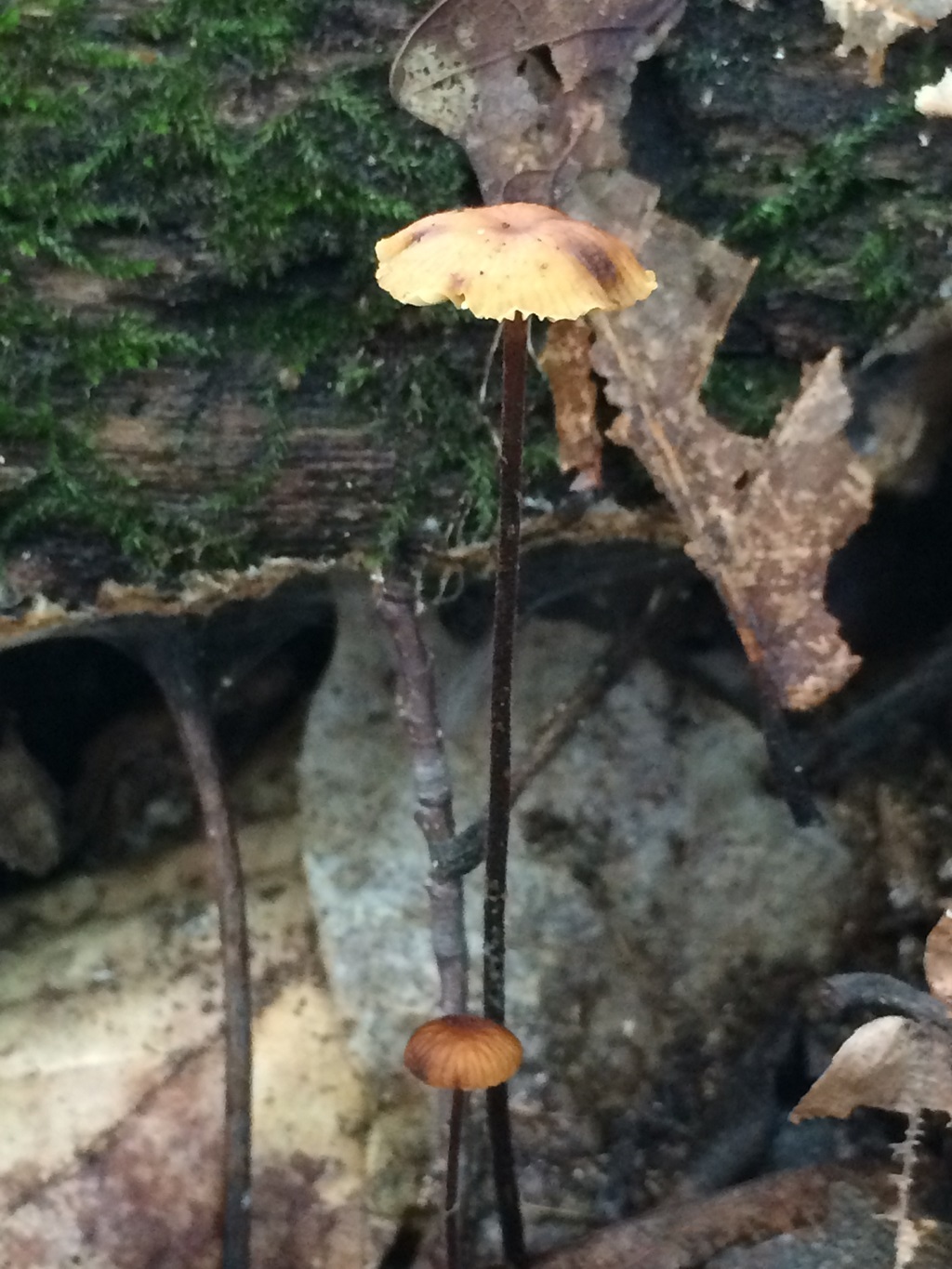
2019-04-16
Picky carnivorous plants?
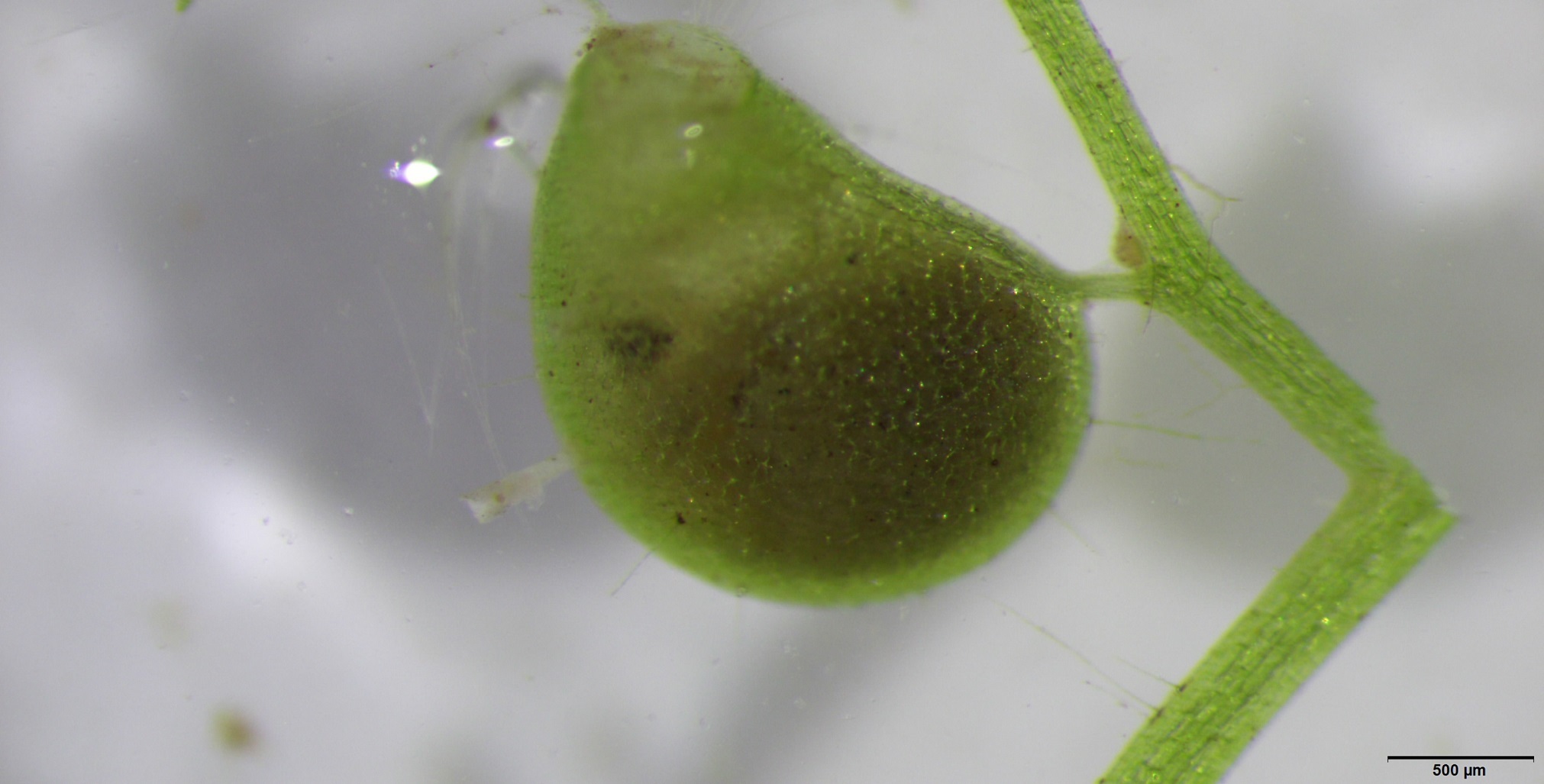
Saskia Klink, Agroecology & Philipp Giesemann, BayCEER Laboratory of Isotope Biogeochemistry
Instead of existing at the bottom of the food chain, some plants have flipped the natural order to become carnivorous. Using specially modified leaf traps, they capture and digest animal prey to tap into an additional nitrogen-nutrient source. But are they picky eaters?
Evolving an extraordinary way of nutrition, carnivorous plants turned the tables by literally eating animal prey to tap on an additional nitrogen-nutrient source. The evolution of trap structures was very creative, for instance from terrestrial sticky leaf traps and pitfalls to aquatic eel traps and suction bladders. Most research on the nutrition of carnivorous plants evaluates the proportion of nitrogen received from a pooled prey sample, however, carnivorous plants may have a picky preference for their prey. Some carnivorous plant species feed on insects, or on seafood like plankton, and some are even vegetarian feeding on leaf litter. Nevertheless, it is not known how picky a carnivorous plant can be. Could the evolution of trapping structures represent a response of the plant to be the first to feed on animal prey before the prey feed on the plant?
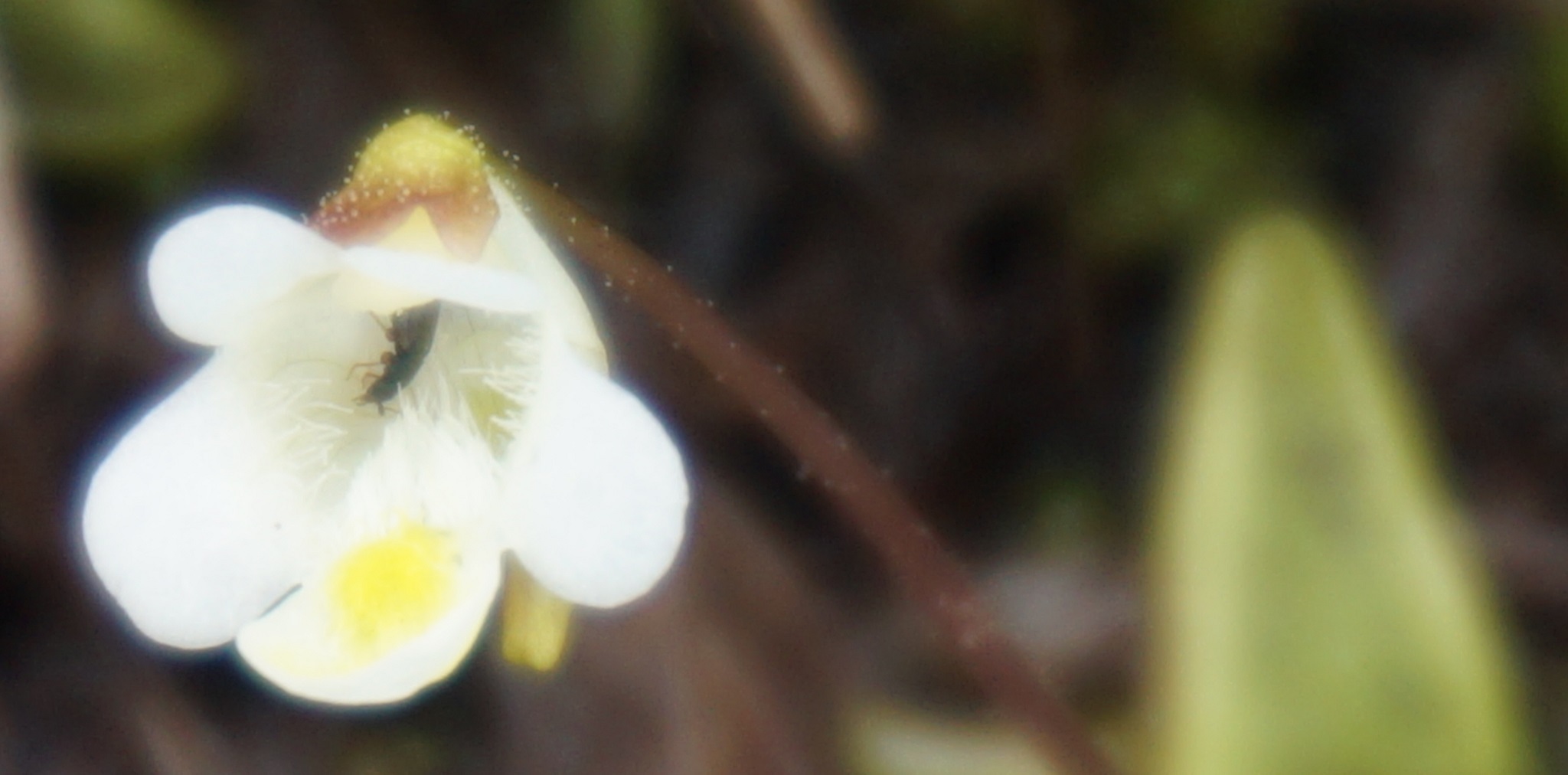
To investigate prey preferences of carnivorous plants, we focused on European carnivores from the Lentibulariaceae family. We sampled the terrestrial butterwort Pinguicula which has sticky leaves to trap terrestrial prey, and the aquatic bladderwort Utricularia which traps aquatic prey with suction bladders. We collected potential prey (insects, plankton) and graded them by trophic level (e.g. phytophagous, zoophagous). We applied a stable isotope natural abundance approach linked with a Bayesian inference isotope mixing model to calculate the carnivorous plants` prey-derived nitrogen uptake.
Overall, the investigated plant species gained around one-third of their total nitrogen from prey. Pinguicula species gained most of their prey-derived nitrogen from herbivorous prey, and only some from zoophagous prey. Utricularia benefitted from zooplankton-derived nitrogen, but also benefitted from phytoplankton, suggesting a ‘vegetarian’ component of their diet. Carnivorous plants might be picky eaters after all.
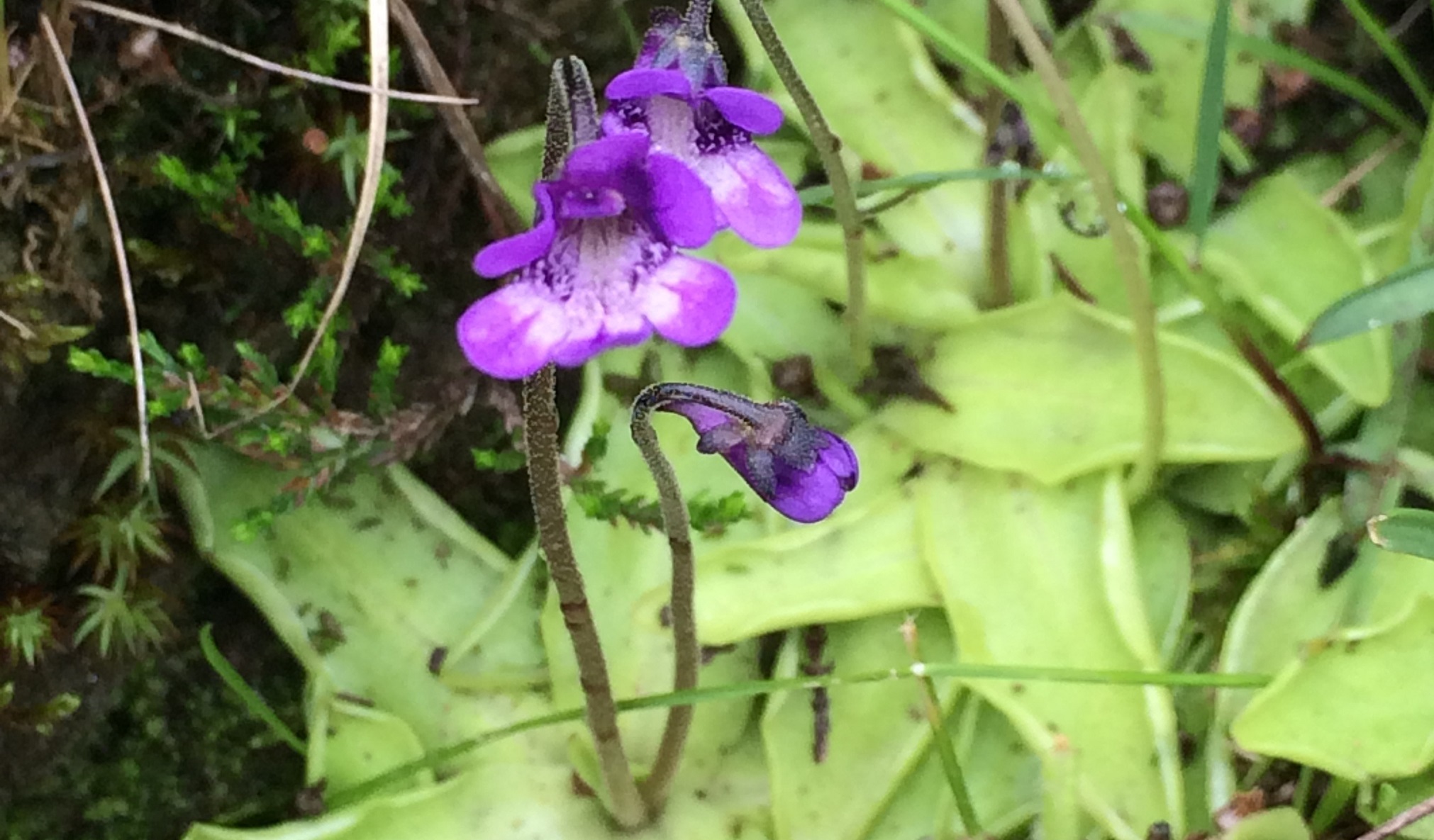
Figure legend:
Bladder traps of Utricularia (top)
Flower of Pinguicula alpina (middle)
Sticky leaf trap and flower of Pinguicula vulgaris (bottom)
Further information:
Klink, S; Giesemann, P; Gebauer, G. (2019): Picky carnivorous plants? Investigating preferences for preys’ trophic levels – a stable isotope natural abundance approach with two terrestrial and two aquatic Lentibulariaceae tested in central Europe, Annals of Botany, doi: 10.1093/aob/mcz022
http://www.bayceer.uni-bayreuth.de/ibg
2019-02-20
Nitrogen enrichment in host plants increases the mortality of common Lepidoptera species
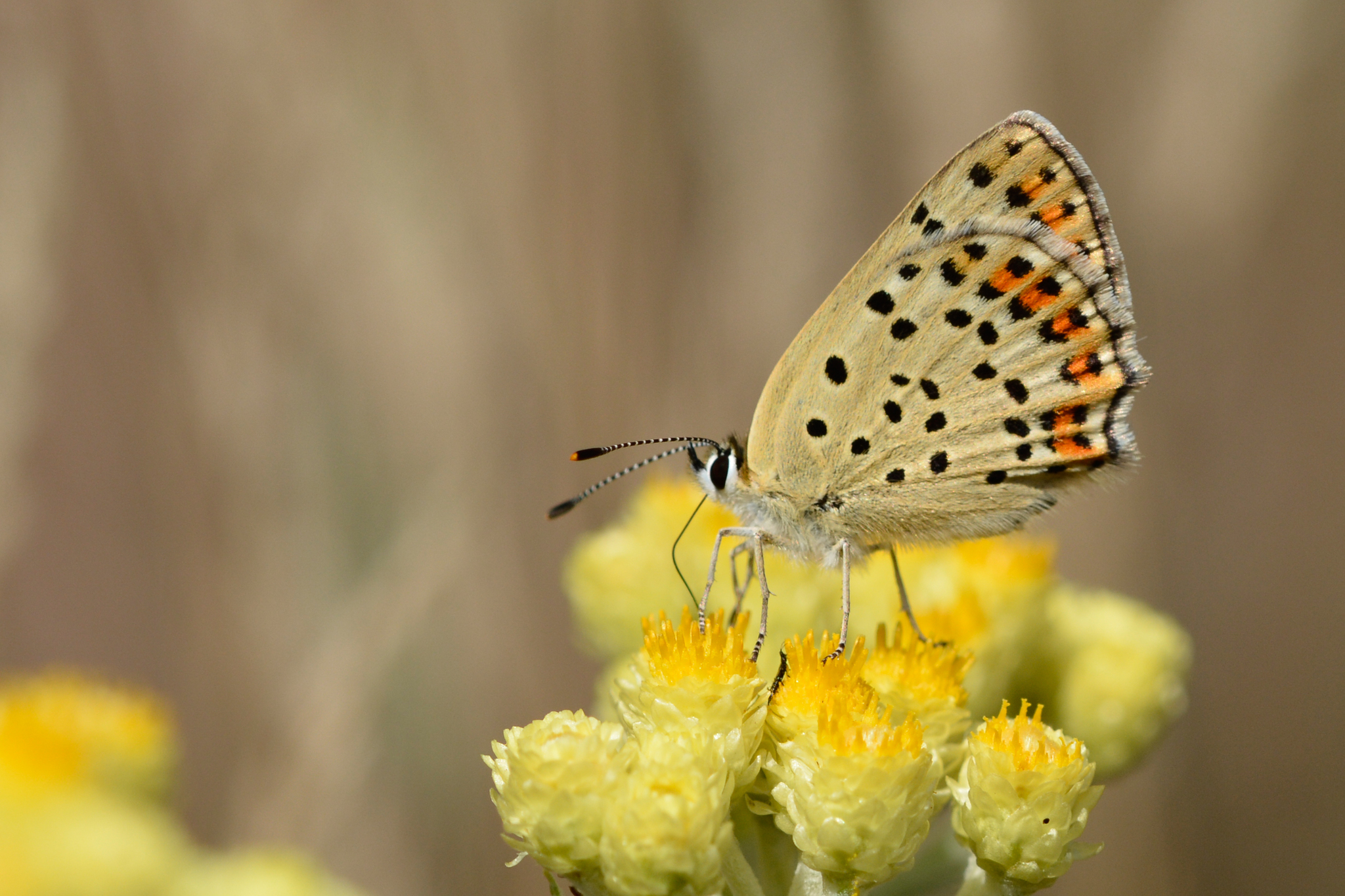
Susanne Kurze, Doctoral student, Functional and Tropical Plant Ecology
The decline of Lepidoptera species is a well-known trend in Central and Western Europe and correlates with the intensification of agriculture in the recent decades. Lepidoptera species are affected by the loss of habitat structures, fragmentation and changes in the land-use intensity. However, fertilization as one important factor going along with agricultural intensification receives almost no attention as potential reason for the decline of Lepidoptera species. This is intriguing, since speculations about its influence on Lepidoptera species exist for several years.
Lepidoptera species as herbivorous insects strongly depend on the nutrient quality of their host plants, which is influenced by agricultural fertilization. Plants use carbon compounds as tissue building blocks and therefore offer only an inadequate diet for herbivorous insects due to their low nitrogen contents. Insects in turn need nitrogen to build proteins as tissue building blocks. Nitrogen is thus considered as the most important nutrient for herbivorous insects. Several studies confirmed that higher nitrogen contents in the diet increase the performance of Lepidoptera species, i.e. the individuals have shorter development times, higher pupal weights or the survival rate of the larvae increases. However, most of these studies considered pest species and the fertilization treatments were not related to agricultural fertilization.
This was the starting point for our investigation focusing on the question how common Lepidoptera species respond to host plants receiving fertilizer quantities commonly used in agriculture. In our study we considered four butterfly and two moth species, which inhabit different habitats, tolerate different land-use intensities and feed on two different host-plant families. Larvae of these six species were fed either with unfertilized or fertilized plants receiving 150 and 300 kg N ha−1 year−1, respectively. These fertilization treatments correspond to quantities usually applied in agriculture.
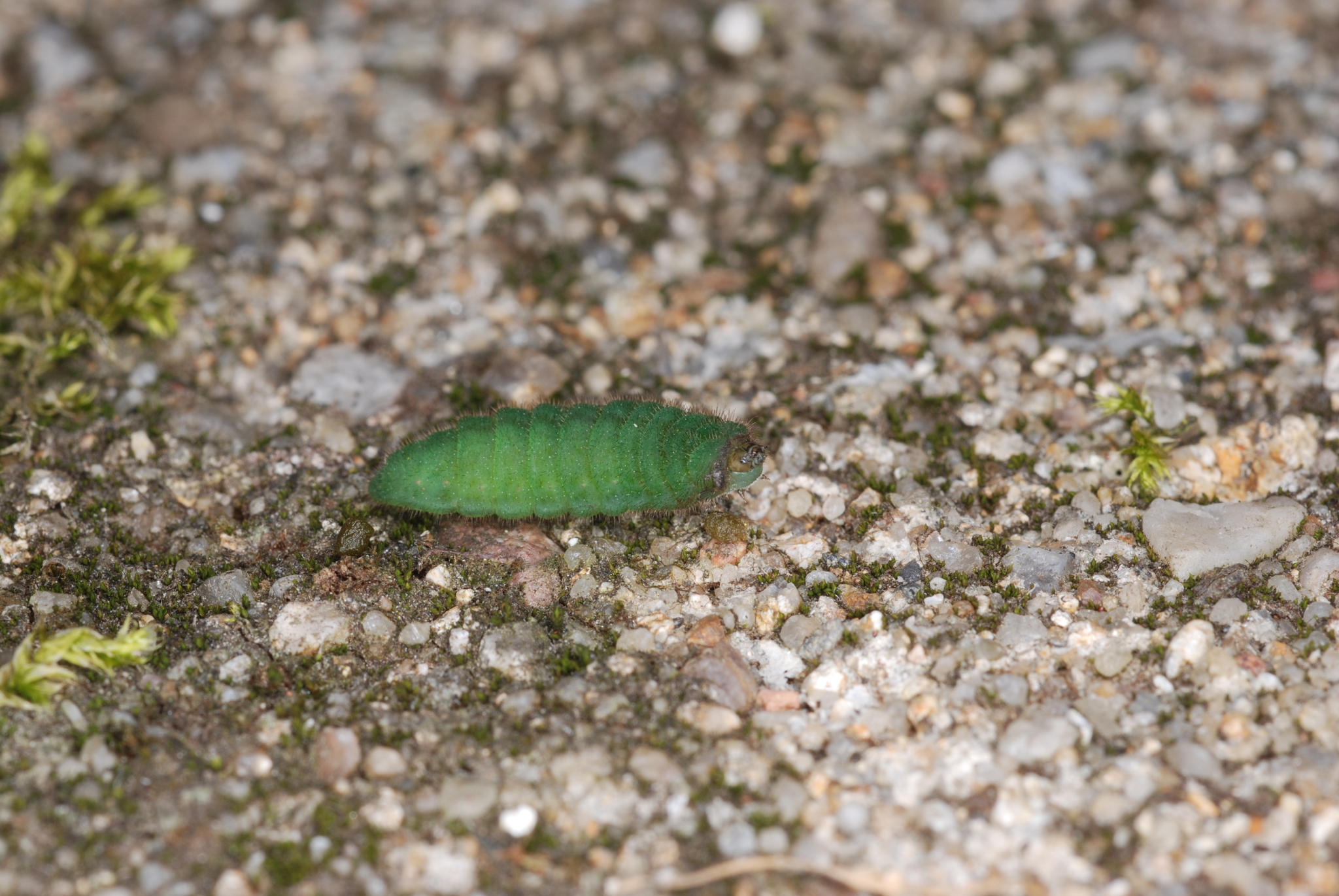
The survival rate of the larvae in all six species feeding on fertilized plants decreased of at least one-third compared to the control group. In the most sensitive moth, the difference of the survival rate between the control group and the 300 kg N ha−1 year−1 treatment was about 70%.
This negative response of all six study species undermines the common assumption that Lepidoptera species benefit from plants with higher nitrogen contents. Instead, the study provides the first evidence that under an experimental setup nitrogen enrichment in plants due to agricultural fertilization significantly increases the mortality of common Lepidoptera species. It is very likely that this effect, which receives so far almost no attention, contributes to the range-wide decline of Lepidoptera species in Western and Central Europe.
Figure legends:
Lycaena tityrus (Brauner Feuerfalter) on Helichrysum arenarium (Sand-Strohblume) © Thomas Fartmann
Larva of Lycaena phlaeas (Kleiner Feuerfalter) © Susanne Kurze
https://link.springer.com/article/10.1007%2Fs00442-018-4266-4
2019-02-10
Glückwunsch! Preiswürdige Ideen bringen den Nahverkehr in Hochfranken ins Rollen
Mit Sebastian Dörner und Carsten Schaller sahnten Anfang Februar zwei Geoökologie-Alumni der Uni Bayreuth im Ideenwettbewerb „Mobilität Digital Hochfranken“ gemeinsam den mit 2000 Euro dotierten zweiten Preis ab. Ziel des vom Institut für Informationssysteme der Hochschule Hof im Rahmen eines Forschungsprojekts ausgeschriebenen Wettbewerbs „MobiDig“ war es, die Mobilität in der Region durch die Entwicklung nachhaltiger und innovativer Konzepte zu stärken.
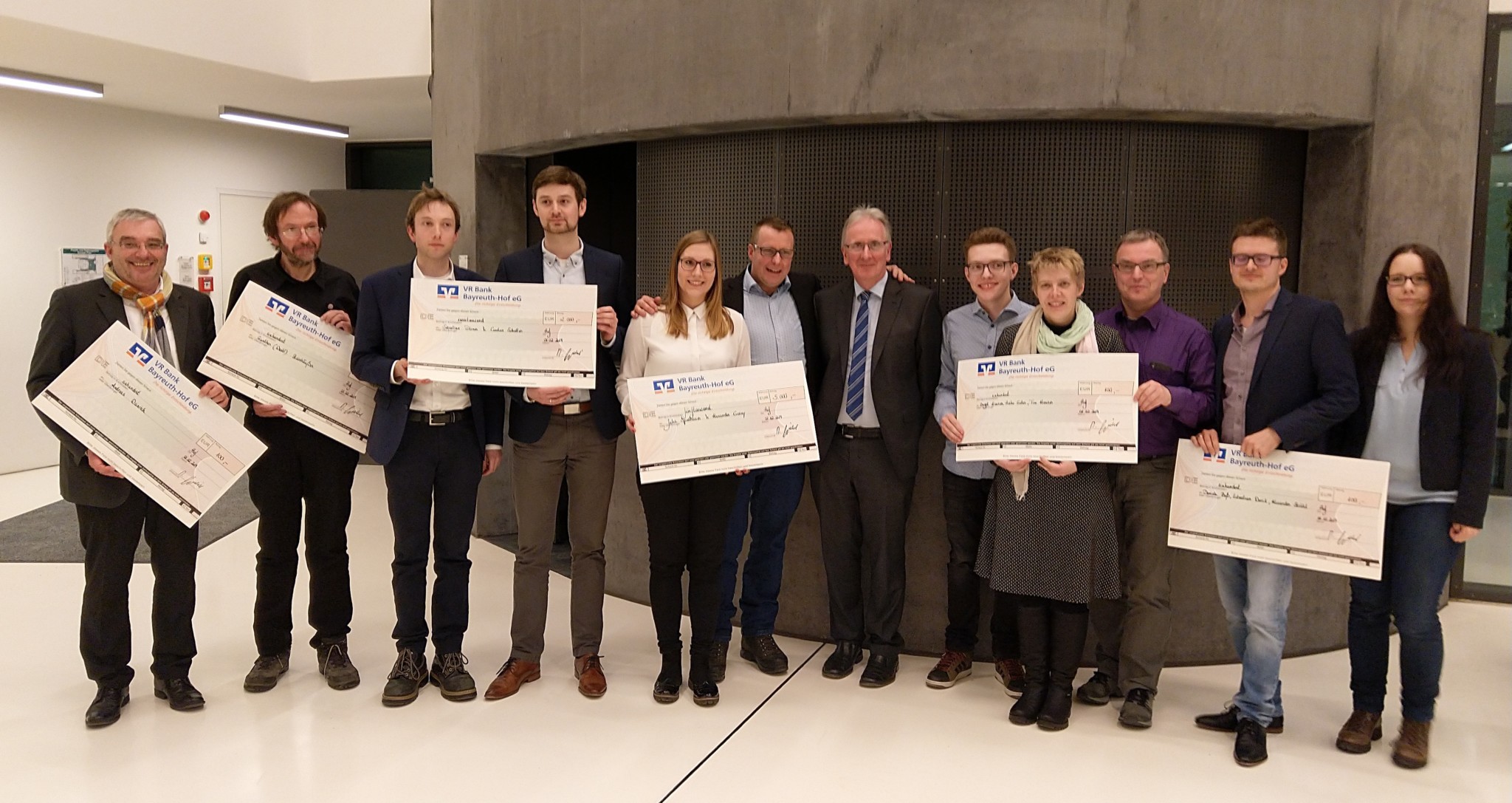
Sebastian Dörner arbeitet im Kompetenznetzwerk Wasser und Energie Oberfranken-Ost in Hof und erzählt: „Durch meinen Umzug in die ländliche Gegend Hochfrankens musste ich zusehen, wie ich bewusst ohne eigenes Auto zur Arbeit komme und habe mich sehr über die schlechte Vermarktung und Umsetzung des ÖPNVs geärgert. Durch meine Netzwerkmanager-Tätigkeit und der lokalen Zeitung bin ich auf den Wettbewerb gestoßen.“ Mit Carsten Schaller, der in der Arbeitsgruppe Klimatologie an der Universität Münster promoviert, holte er sich einen ebenfalls sehr am öffentlichen Personennahverkehr Interessierten mit ins Boot. Sie waren sich einig: gerade vor dem Hintergrund der oft eher von Stillstand bestimmten Debatten zum Klimawandel ist der Verkehrssektor mit 18% der CO2-Gesamtemissionen in Deutschland ein Bereich, in dem etwas verändert werden muss - und kann!
In ihrem Verbundkonzept „Bahn - Schnellbus – Hochfranken Rufauto (Hora)" schlagen sie drei Maßnahmen vor, um nach dem Grundsatz „Das Angebot generiert die Nachfrage!“ den öffentlichen Nahverkehr deutlich attraktiver zu gestalten: Schnellbusse sollen die Lücken im Schnellverkehr zwischen den Oberzentren schließen und wie die Bahn im Stundentakt verkehren. Der Anschluss der Dörfer an den Schnellverkehr wird vom ebenfalls im Stundentakt verkehrenden Hora geleistet. Diese Weiterentwicklung und sinnvolle Koppelung bereits bestehender Konzepte (Bahn, Bus, Anrufsammeltaxi) ist verhältnismäßig schnell umsetzbar und und wird als Verbund aus einer Hand vermarktet - mit gemeinsamem Fahrschein, Fahrplan und App, um den abschreckenden „Fahrkartendschungel" zu lichten.
Das Ergebnis wäre eine bessere Land-Stadt-Verknüpfung im Stundentakt statt wie heute oft nur zwei bis drei Busverbindungen pro Tag. Die Nutzer sparen Zeit schon beim „Buchen in einem Aufwasch“ sowie durch die Taktung mit Schnellbussen und Zugverkehr. Erwartet wird zudem eine bessere Auslastung der öffentlichen Fahrzeuge. Die beiden Preisträger schließen ihr Konzept mit einem Zeitplan für die notwendigen Schritte zur Umsetzung bis zum – angestrebten – Beitritt der Landkreise Hof, Kronach, Kulmbach und Wunsiedel sowie der kreisfreien Stadt Hof zum Verkehrsverbund Großraum Nürnberg VGN. Während das Preisgeld von den Gewinnern in die private Fahrradmobilität und einen Sprachkurs investiert wird, dürfen wir in Oberfranken nun gespannt sein, welche Teile der prämierten Konzepte tatsächlich umgesetzt werden.
(Text: Birgit Thies, Bild: Landratsamt Hof)
Offizieller Bericht über die Preisverleihung (LK Hof):
https://www.landkreis-hof.de/sieger-des-mobidig-wettbewerbs-ausgezeichnet/
2014-10-14
BayEOSViewer 1.0.0 released
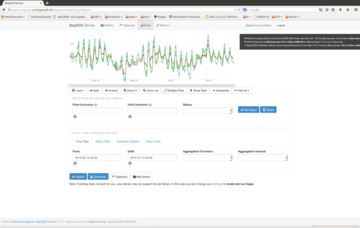 Four month after developement release the BayCEER IT group released the first stable version of the new BayEOS server viewer.
Four month after developement release the BayCEER IT group released the first stable version of the new BayEOS server viewer.
BayEOS viewer is a server application written in PHP. It communicates with the BayEOS server backend via the XML-RPC interface.
Like BayEOS gateway the BayEOS viewer layout is based on the Bootstrap CSS. Bootstrap CSS allows one web applications to run smoothly on small smart phone divices as well as on large dektop computers.
In the long run, BayEOS viewer will replace the data browser GOAT. For easy installations debian packages are available.
Back to the News

